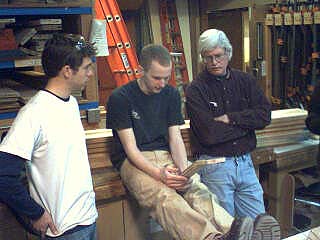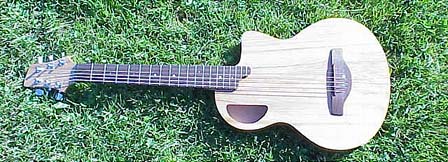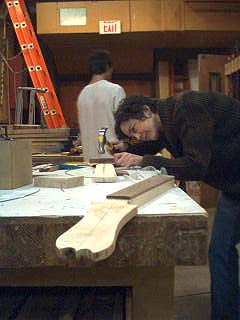Class offers students chance to build their own guitarsTurning "a hunk of wood" into a real instrumentBy Christopher ArnoldTuesday at 7:30 p.m., the corridors of the Erb Memorial Union are nearly empty. Inside the University Craft Center, a small facility tucked away in the same building as student government offices, a few students chat while making some handmade jewelry.
Behind them is an old set of wooden double doors. When the doors swing open the whir of power tools fills the room. Welcome to the Craft Center woodshop. On the wall, a large shelving system houses a coffee table, a set of drawers, a large picture frame and a few other partially completed items. Tonight, though, those projects play second fiddle to the skeletons of eight guitars strewn along the five white tables in the center of the room. In three more weeks, some of these instruments will be ready to rock. Guitar Making is offered each term throughout the academic year through the University Craft Center. Students do not enroll for credit, but rather for the opportunity to learn a new skill and, if all goes well, to have an instrument to take home. The class was developed by Peter Kirkpatrick, 22, a local musician and luthier who has been crafting his own instruments for nine years. Kirkpatrick has been guiding others here in the woodshop since he was a freshman at the University in 1999. The project this term is to create a "backpacker" guitar, a travel-size version of a full-sized acoustic. The design is easier to manage and more affordable than an electric guitar project, which Kirkpatrick has taught in the past. "Any class is about learning, not about having a perfect finished product," Kirkpatrick says. "I just want people to get excited about guitars."
Warren Baumann, a 19-year-old University freshman, is sanding the fret board of his guitar. This piece of walnut must be extremely smooth because this is where the guitarist will move his or her fingers along the neck of the guitar to create different notes and chords. Baumann first tried to build a guitar years ago but didn't have the proper tools. He has spent about 20 hours on his backpacker guitar. "It's happened a lot faster than I thought," Baumann said. "I started with a block of wood, and it's cool to see the progress." Baumann says that Kirkpatrick's instruction has made the process more manageable. "Pete knows what he's doing," Baumann says. "It's a small class and he watches everyone. He's always willing to help." When it comes to acoustics, accuracy is everything. Baumann begins work on his fret board inlays, the small pieces of pearl inserted into the neck of the guitar at regular intervals on the fret board. This process requires careful use of a utility razor. "I took three and a half-years of cabinet making in high school," he says, "but I've never done anything this detailed before." Alani Kelly, a 19-year-old University freshman, is preparing to insert a set of pearl inlays into the fret board of her guitar. "I've built some random things," she says, "but not much with big tools. It's easier than I thought." She carefully measures the centerline of the guitar neck with a ruler and glides a pencil along the fret board.
"Last term I took 18 credits," she says. "I wanted a fun class. An instrument is such a gift, and to be able to make one yourself is incredible." According to Kirkpatrick, who has helped more than 80 students over the past three years, 50 to 75 percent of students will complete their guitars by the end of the term. "It takes a lot of time outside the class," he says, "but I'm also here to help people out on Thursdays." Kirkpatrick works with a teaching assistant because student projects require a lot of attention. This term Kirkpatrick's assistant is Dan Gilmore, a local woodworker and a former student in Kirkpatrick's electric guitar making class. "I love guitars," says Gilmore, a tall, white-haired man who strolls from student to student, offering advice and praising their work.
The fee for the class is $129. Space is limited to eight students, and spaces are filled quickly, Kirkpatrick says. No woodworking experience is required, but Kirkpatrick warns that it is a large and complex project. It is best to show up in person on the day of Craft Center registration, Kirkpatrick says. Those interested should call 346-4361 for details. After six weeks, Caitlin Gamble, an 18-year-old University freshman, says she is pleased with her progress. "I've played the guitar off and on for four years," she says. "I play a lot of classic rock." She shows the body of her guitar, and then goes searching through the woodshop cabinets for the neck of her instrument. When she returns, she sets the disembodied neck next to the body of the guitar on the table in front of her. "I started with a hunk of wood," she says. "I cut out the rim, glued on the back, put some bracing stuff inside and glued the top on, then I glued a hunk of wood here," she says, pointing to where the neck meets the body. "I've never done any woodworking," she says, "but I got used to the band saw." |



